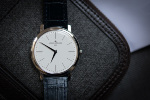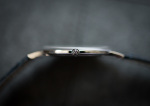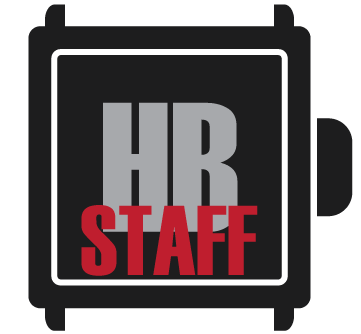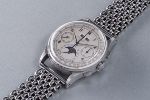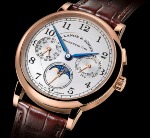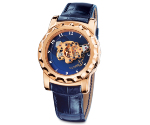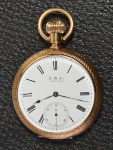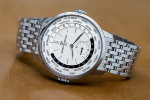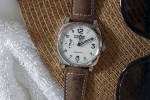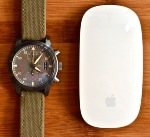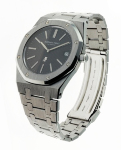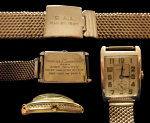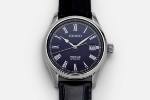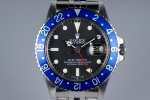Blancpain (1735)
Blancpain is known to be the oldest registered watchmaking brand in the world. It was founded in 1735 in Villeret, Switzerland, by Jehan-Jaques Blancpain. The company was family managed until 1932, when two staff members bought the business and the name of the company was changed to Rayville-Blancpain. In 1953, the company launched the Fifty Fathoms diving watch, one of its most famous models. By the end of the 1950s, Blancpain was producing more than 100,000 watches per year. The company went out of business for a while. The company was eventually renamed Blanpain and sold to Swatch. The company says it has never produced a quartz watch, and will never will. Every Blancpain watch is assembled entirely by hand by a single watchmaker.
A Fifth Fathoms Bathyscaphe:
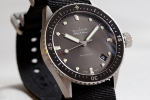
Favre Leuba (1737)
Abraham Favre registered as a watchmaker in Le Locle, Switzerland, in 1737. Auguste Leuba joined theh company in 1815, and it became known as Favre-Leuba. The motto is creating timepieces “for those who conquer frontiers”. In 1962, they launched the classic Bivouac watch. This was the first wristwatch to measure altitude and air pressure. As a result, it was popular amongst mountaineers and pilots. The company started having troubles when inexpensive quartz watches appeared in 1969. The owners had to sell the brand in the 1980s. After changing hands several times, the company is owned by Titan Company Limited since 2011.
A Bivouac watch featuring an altimeter/barometer:

Jaquet Droz (1738)
In 1738, Pierre Jaquet Droz started manufacturing in La Chaux-de-Fonds, Switzerland. He produced timepieces as well as mechanical art pieces that incorporated music and movement (called Automata). The work of Jaquet Droz was popular amongst a wealthy audience in Europa and even China. The Napoleonic Wars at the beginning of the 19th century brought an end to the creative and prosperous time for the brand. In 2000, it was acquired by the Swatch Group. Since then, new magnificent timepieces are launched, marking the start of a new Jaquet Droz
A Jaquet Droz Grande Seconde Quantieme Ivory Enamel:
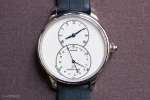
Ferdinand Berthoud (1753)
Ferdinand Berthoud was a watchmaker and a scientist. He started his workshop in Paris, France, in 1753. The brand went into silence in 1876 after the death of Ferdinand’s heir, Charles-Auguste Berthoud. It was relaunched in 2015 with the Chronomètre Ferdinand Berthoud FB1 watch.
A Chronomètre Ferdinand Berthoud FB1:

Vacheron Constantin (1755)
This company was founded in Geneva, Switzerland, in 1755, by Jean-Marc Vacheron. The company was founded 20 years after the world’s oldest registered brand (Blancpain), but it is the continuously operating watchmaker in the world. The company’s motto is great: "Do better if possible and that is always possible.” Since 1996, the company has been owned by the Swiss Richemont Group. In 2015, the company produced the Reference 57260, the world's most complicated mechanical watch. It took three watchmakers eight years to build the 57 complication watch for a client.
A Vacheron Constantin Overseas Dual-Time:
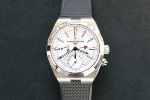
Breguet (1775)
Breguet was founded by Abraham-Louis Breguet in 1775 in Paris. Since 1976, it has produced watches in Vallée de Joux, Switzerland. In 1910, the company produced the first wrist watch. The tourbillon movement was invented by Abraham-Louis Breguet. The company has created pieces owned by Marie Antoinette and Bonaparte. In 1999, Brugeut was acquired by the Swatch Group.
A Classique Tourbillon Extra-Plat Automatique 5367:
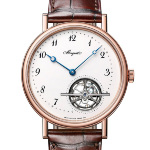
Gallet & Co. (1826)
This company is actually the oldest watch and clock making house. It’s history dates back to Humbertus Gallet, a clock maker who became a Swiss citizen in 1466. Julien Gallet registered the company’s name in 1826. Today, the company produces timepieces that use modern technology and style to keep it ticking along.
Here is a pic of the Flying Officer, a watch worn by U.S. President Harry Truman:
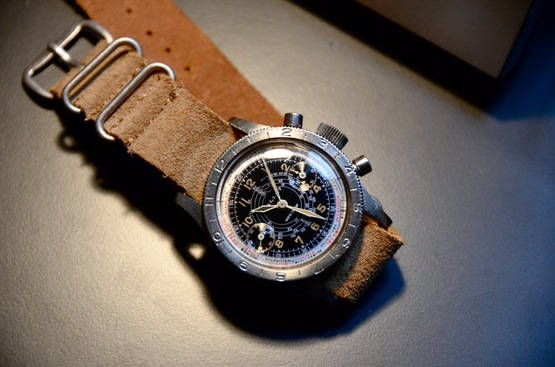
Longines (1832)
Longines was founded in 1832 in Saint-Imier, Switzerland, by Auguste Agassiz. Its winged hourglass logo was registered in 1889 and is the oldest registered trademark for a watchmaker. The company is now owed by the Swatch Group.
A Longines Heritage 1945:
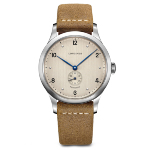
Jaeger-LeCoulter (1833)
Antoine Lecoultre founded a watchmaking workshop in 1833. In 1866, he and his son established LeCoulter & Cie. In 1870, the company developed the first partially mechanized production processes for complicated movements. In 1903, Paris-based watchmaker to Edmond Jaeger challenged Swiss manufacturers to develop and produce the ultra-thin movements that he had invented. Antoine’s grandson, Jacques-David LeCoultre, accepted the challenge. This resulted in a a collection of ultra-thin pocket watches, including the thinnest in the world in 1907. The same year, The collaboration between Jaeger and LeCoultre led to the company being officially renamed Jaeger-LeCoultre in 1937. Since 2000, the company has been a fully owned subsidiary of Richemont.
A Jaeger-LeCoultre Master Ultra-Thin Jubilee. At 4.06mm, it is the thinnest mechanical watch in the world:
